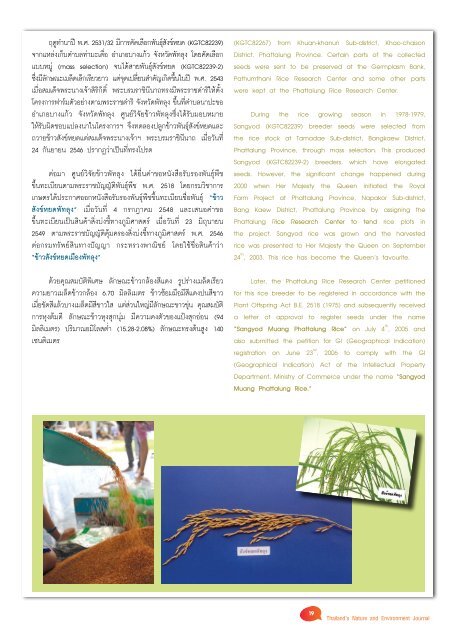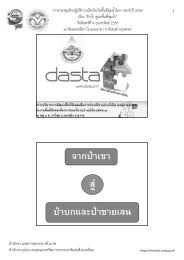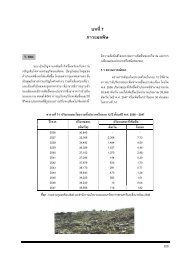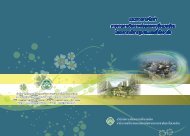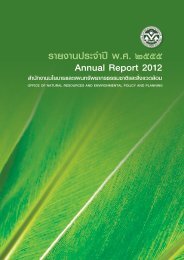ปีที่ 5 ฉบับที่ 3 กรกฎาคม-กันยายน 2552 - สำนักงานนโยบายและแผน ...
ปีที่ 5 ฉบับที่ 3 กรกฎาคม-กันยายน 2552 - สำนักงานนโยบายและแผน ...
ปีที่ 5 ฉบับที่ 3 กรกฎาคม-กันยายน 2552 - สำนักงานนโยบายและแผน ...
Create successful ePaper yourself
Turn your PDF publications into a flip-book with our unique Google optimized e-Paper software.
ฤดูทํานาปี พ.ศ. 2531/32 มีการคัดเลือกพันธุ ์สังข์หยด (KGTC82239)<br />
จากแหล่งเก็บตําบลท่ามะเดื่อ อําเภอบางแก้ว จังหวัดพัทลุง โดยคัดเลือก<br />
แบบหมู่ (mass selection) จนได้สายพันธุ์สังข์หยด (KGTC82239-2)<br />
ซึ ่งมีลักษณะเมล็ดเล็กเรียวยาว แต่จุดเปลี ่ยนสําคัญเกิดขึ ้นในปี พ.ศ. 2543<br />
เมื่อสมเด็จพระนางเจ้าสิริกิติ์ พระบรมราชินีนาถทรงมีพระราชดําริให้ตั้ง<br />
โครงการฟาร์มตัวอย่างตามพระราชดําริ จังหวัดพัทลุง ขึ้นที่ตําบลนาปะขอ<br />
อําเภอบางแก้ว จังหวัดพัทลุง ศูนย์วิจัยข้าวพัทลุงซึ่งได้รับมอบหมาย<br />
ให้รับผิดชอบแปลงนาในโครงการฯ จึงทดลองปลูกข้าวพันธุ์สังข์หยดและ<br />
ถวายข้าวสังข์หยดแด่สมเด็จพระนางเจ้าฯ พระบรมราชินีนาถ เมื่อวันที่<br />
24 <strong>กันยายน</strong> 2546 ปรากฏว่าเป็นที่ทรงโปรด<br />
ต่อมา ศูนย์วิจัยข้าวพัทลุง ได้ยื่นคําขอหนังสือรับรองพันธุ์พืช<br />
ขึ้นทะเบียนตามพระราชบัญญัติพันธุ์พืช พ.ศ. 2518 โดยกรมวิชาการ<br />
เกษตรได้ประกาศออกหนังสือรับรองพันธุ์พืชขึ้นทะเบียนชื่อพันธุ์ “ข้าว<br />
สังข์หยดพัทลุง” เมื่อวันที่ 4 <strong>กรกฎาคม</strong> 2548 และเสนอคําขอ<br />
ขึ้นทะเบียนเป็นสินค้าสิ่งบ่งชี้ทางภูมิศาสตร์ เมื่อวันที่ 23 มิถุนายน<br />
2549 ตามพระราชบัญญัติคุ้มครองสิ่งบ่งชี้ทางภูมิศาสตร์ พ.ศ. 2546<br />
ต่อกรมทรัพย์สินทางปัญญา กระทรวงพาณิชย์ โดยใช้ชื่อสินค้าว่า<br />
“ข้าวสังข์หยดเมืองพัทลุง”<br />
ด้วยคุณสมบัติพิเศษ ลักษณะข้าวกล้องสีแดง รูปร่างเมล็ดเรียว<br />
ความยาวเมล็ดข้าวกล้อง 6.70 มิลลิเมตร ข้าวซ้อมมือมีสีแดงปนสีขาว<br />
เมื่อขัดสีแล้วบางเมล็ดมีสีขาวใส แต่ส่วนใหญ่มีลักษณะขาวขุ่น คุณสมบัติ<br />
การหุงต้มดี ลักษณะข้าวหุงสุกนุ่ม มีความคงตัวของแป้งสุกอ่อน (94<br />
มิลลิเมตร) ปริมาณอมิโลสต่ํา (15.28-2.08%) ลักษณะทรงต้นสูง 140<br />
เซนติเมตร<br />
(KGTC82267) from Khuan-khanun Sub-district, Khao-chaison<br />
District, Phattalung Province. Certain parts of the collected<br />
seeds were sent to be preserved at the Germplasm Bank,<br />
Pathumthani Rice Research Center and some other parts<br />
were kept at the Phattalung Rice Research Center.<br />
During the rice growing season in 1978-1979,<br />
Sangyod (KGTC82239) breeder seeds were selected from<br />
the rice stock at Tamadae Sub-district, Bangkaew District,<br />
Phattalung Province, through mass selection. This produced<br />
Sangyod (KGTC82239-2) breeders, which have elongated<br />
seeds. However, the significant change happened during<br />
2000 when Her Majesty the Queen initiated the Royal<br />
Farm Project at Phattalung Province, Napakor Sub-district,<br />
Bang Kaew District, Phattalung Province by assigning the<br />
Phattalung Rice Research Center to tend rice plots in<br />
the project. Sangyod rice was grown and the harvested<br />
rice was presented to Her Majesty the Queen on September<br />
24 th , 2003. This rice has become the Queen’s favourite.<br />
Later, the Phattalung Rice Research Center petitioned<br />
for this rice breeder to be registered in accordance with the<br />
Plant Offspring Act B.E. 2518 (1975) and subsequently received<br />
a letter of approval to register seeds under the name<br />
“Sangyod Muang Phattalung Rice” on July 4 th , 2005 and<br />
also submitted the petition for GI (Geographical Indication)<br />
registration on June 23 rd , 2006 to comply with the GI<br />
(Geographical Indication) Act of the Intellectual Property<br />
Department, Ministry of Commerce under the name “Sangyod<br />
Muang Phattalung Rice.”<br />
19<br />
Thailand’s Nature and Environment Journal


